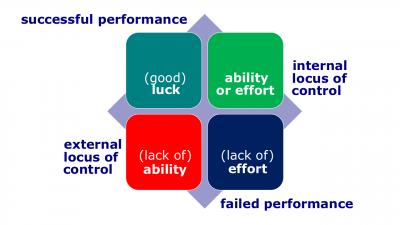Difference between revisions of "Attribution theory"
MariamKhalid (talk | contribs) |
|||
| (2 intermediate revisions by one other user not shown) | |||
| Line 1: | Line 1: | ||
[[Attribution theory]] (hereinafter, the ''Theory'') is a theory used to explain how we judge people differently depending on what meaning we attribute to a given behavior. This ''theory'' also attempts to determine whether an individual's behavior is internally or externally caused.<blockquote><table class="wikitable" width=100% style="text-align:center;"><tr><td>[[Attribution factor|Factor]]s</td><th>[[Observation]]</th><th>[[Interpretation]]</th><th>[[Attribution]]</th></tr><tr><th rowspan="2">[[Distinctiveness factor|Distinctiveness]]</th><td>The individual behaves this way in other situations</td><td>Low distinctiveness</td><td>[[Dispositional attribution|Internal]]</td></tr><tr><td>The individual behaves differently in other situations</td><td>High distinctiveness</td><td>[[Situational attribution|External]]</td></tr><tr><th rowspan="2">[[Consensus factor|Consensus]]</th><td>Other people behave the same way in similar situations</td><td>High consensus</td><td>[[Situational attribution|External]]</td></tr><tr><td>Other people behave differently in similar situations</td><td>Low consensus</td><td>[[Dispositional attribution|Internal]]</td></tr><tr><th rowspan="2">[[Consistency factor|Consistency]]</th><td>The individual behaves this way consistently</td><td>High consistency</td><td>[[Dispositional attribution|Internal]]</td></tr><tr><td>The individual behaves this way rarely</td><td>Low consistency</td><td>[[Situational attribution|External]]</td></tr></table></blockquote>[[File:Attribution-theory.png|400px|thumb|right|[[Attribution theory]]]] | [[Attribution theory]] (hereinafter, the ''Theory'') is a theory used to explain how we judge people differently depending on what meaning we attribute to a given behavior. This ''theory'' also attempts to determine whether an individual's behavior is internally or externally caused.<blockquote><table class="wikitable" width=100% style="text-align:center;"><tr><td>[[Attribution factor|Factor]]s</td><th>[[Observation]]</th><th>[[Interpretation]]</th><th>[[Attribution]]</th></tr><tr><th rowspan="2">[[Distinctiveness factor|Distinctiveness]]</th><td>The individual behaves this way in other situations</td><td>Low distinctiveness</td><td>[[Dispositional attribution|Internal]]</td></tr><tr><td>The individual behaves differently in other situations</td><td>High distinctiveness</td><td>[[Situational attribution|External]]</td></tr><tr><th rowspan="2">[[Consensus factor|Consensus]]</th><td>Other people behave the same way in similar situations</td><td>High consensus</td><td>[[Situational attribution|External]]</td></tr><tr><td>Other people behave differently in similar situations</td><td>Low consensus</td><td>[[Dispositional attribution|Internal]]</td></tr><tr><th rowspan="2">[[Consistency factor|Consistency]]</th><td>The individual behaves this way consistently</td><td>High consistency</td><td>[[Dispositional attribution|Internal]]</td></tr><tr><td>The individual behaves this way rarely</td><td>Low consistency</td><td>[[Situational attribution|External]]</td></tr></table></blockquote>[[File:Attribution-theory.png|400px|thumb|right|[[Attribution theory]]]] | ||
| + | |||
| + | ==Definitions== | ||
| + | According to [[Organizational Behavior by Robbins and Judge (17th edition)]], | ||
| + | :[[Attribution theory]]. An attempt to determine whether an individual's behavior is internally or externally caused. | ||
| + | According to [[Management by Robbins and Coulter (14th edition)]], | ||
| + | :[[Attribution theory]]. A theory used to explain how we judge people differently depending on what meaning we attribute to a given behavior. | ||
==Key concepts== | ==Key concepts== | ||
| Line 5: | Line 11: | ||
*[[Self-serving bias]]. The tendency for individuals to attribute their own successes to internal factors while putting the blame for failures on external factors. | *[[Self-serving bias]]. The tendency for individuals to attribute their own successes to internal factors while putting the blame for failures on external factors. | ||
| − | ==Related | + | ==Related lectures== |
| − | *[[Human Perceptions Quarter]]. | + | *[[Human Perceptions Quarter]]. |
==See also== | ==See also== | ||
*[[Attribution theory of leadership]]. | *[[Attribution theory of leadership]]. | ||
| − | [[Category: Septem Artes Administrativi]][[Category: Articles]] | + | [[Category:Management]][[Category: Septem Artes Administrativi]][[Category: Articles]] |
Latest revision as of 09:27, 3 June 2020
Attribution theory (hereinafter, the Theory) is a theory used to explain how we judge people differently depending on what meaning we attribute to a given behavior. This theory also attempts to determine whether an individual's behavior is internally or externally caused.
Factors Observation Interpretation Attribution Distinctiveness The individual behaves this way in other situations Low distinctiveness Internal The individual behaves differently in other situations High distinctiveness External Consensus Other people behave the same way in similar situations High consensus External Other people behave differently in similar situations Low consensus Internal Consistency The individual behaves this way consistently High consistency Internal The individual behaves this way rarely Low consistency External
Definitions
According to Organizational Behavior by Robbins and Judge (17th edition),
- Attribution theory. An attempt to determine whether an individual's behavior is internally or externally caused.
According to Management by Robbins and Coulter (14th edition),
- Attribution theory. A theory used to explain how we judge people differently depending on what meaning we attribute to a given behavior.
Key concepts
- Fundamental attribution error. The tendency to underestimate the influence of external factors and overestimate the influence of internal factors when making judgments about the behavior of others.
- Self-serving bias. The tendency for individuals to attribute their own successes to internal factors while putting the blame for failures on external factors.
